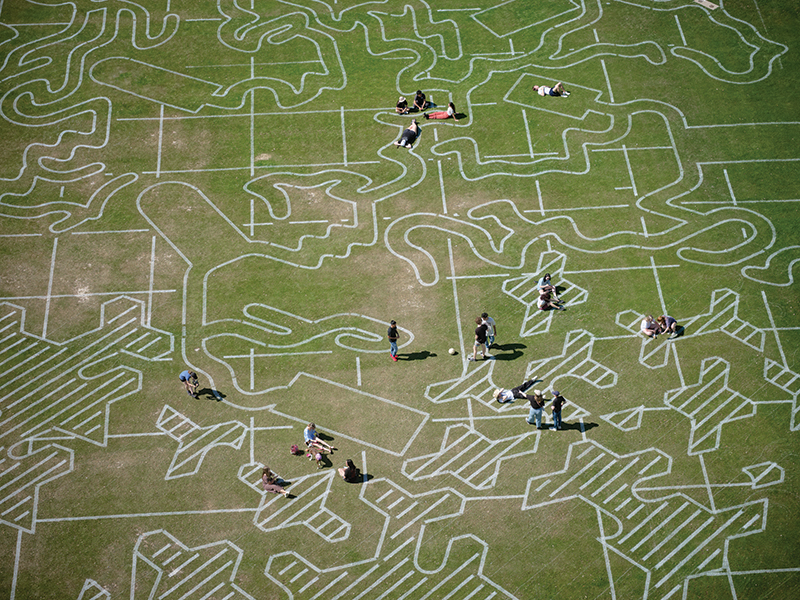Labyrinth was a fleeting installation. Monumental in size, it appeared and vanished in the space of a week. The project was the outcome of a workshop at Texas A&M University led by Outpost Office’s Ashley Bigham and Erik Herrmann, who are also faculty members at the Ohio State University Knowlton School of Architecture. The designers were invited to A&M by the school’s AIAS chapter as part of the department of architecture’s Spring 2022 Lecture Series, ASSEMBLY.
Designed to help students develop new skills and support their return to the physical studio after 18 months of online learning, the workshop took place in two parts: a virtual visit from Outpost Office in February 2022, and an installation in March. Bigham and Herrmann introduced labyrinths as an archetype and framework at the intersection of space and logic. Afterwards, students organized into seven groups, each using a custom software developed by the firm to create a unique labyrinth. After some initial exploratory play, groups were encouraged to develop their designs more intentionally, not just evaluating each labyrinth in terms of its privileged overhead compositional appearance, but simultaneously considering an embodied experience. That is, what would the labyrinth be like to explore and hang out in?
Measuring 250 by 350 feet, the East Quad on the campus of Texas A&M University is a sparse island of manicured turf that is rarely occupied. Each side is flanked by a major pedestrian corridor and anchored by academic buildings (including, conveniently, the School of Architecture to the north.) The workshop approached this quad as a platform for social gatherings where follies created in the School of Architecture could spill onto the green and add value to campus life.
Outpost Office capitalized on the opportunity to take this underutilized site — a blank canvas — and fill it up. Adding complexity to the ambitious undertaking, they soon realized that this would need to be a low-impact project that could be installed quickly, that required minimal human labor, and that was as inexpensive as possible. On March 25, accompanied by two GPS-guided field-marking drones and 10 gallons of VOC-free, non-toxic paint, Outpost Office appropriated vector fields from the workshop and turned them into instructions for the robots to paint.
Gradually, lines connected to others, inscribing recognizable figures. As people started to arrive, they asked questions, walked around, and looked for different vantage points to make sense of what was happening. Twenty-four hours into the installation, the two-acre East Quad began to feel reorganized, and by the end of the second day the quad had been reconfigured into a composite field of labyrinths: The once vast, empty island became an archipelago of mazes, a meta-framework that integrated patterns and logics from each of the seven student groups.
The process of building up lines, the presentation of the finished labyrinth, and its ultimate erasure by mowing was a performance in itself. There were no prescribed uses for the installation, and it was a delight to observe how the act of painting the field radically reshaped the space physically. How we gather and interact (or don’t) — the dynamics of our individual and collective bodies and behaviors — have also changed in response to the past three years. Outpost Office and Texas A&M AIAS responded with a project that negotiates those tensions and social dynamics through a collectively authored architecture.
James Michael Tate, Assoc. AIA, is an assistant professor of architecture at Texas A&M University and runs the practice T8projects.

